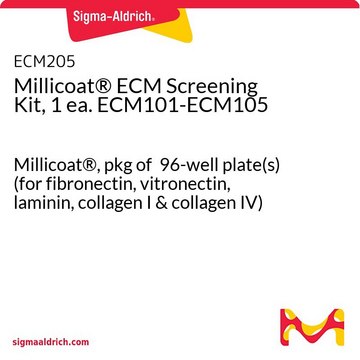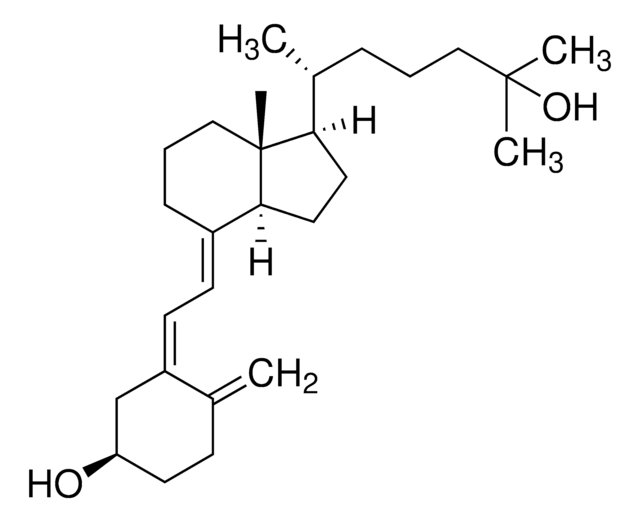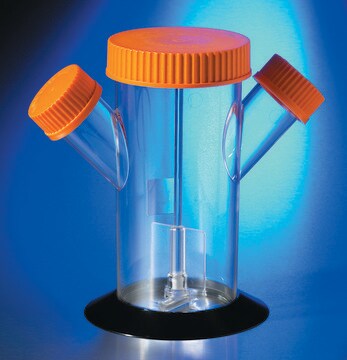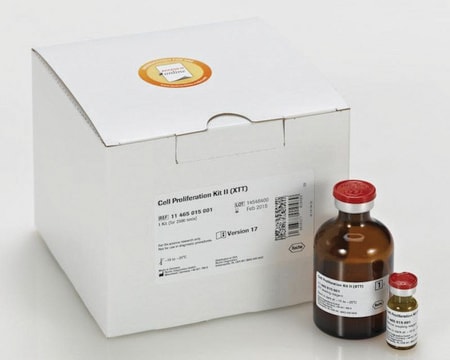ECM531
β Integrin-mediated Cell Adhesion Array Kit, colorimetric
This assay can substitute for FACS analysis & is useful for screening human adherent cells for cell surface integrins or for monitoring in vitro cell differentiation or genetic modification of cells.
Sign Into View Organizational & Contract Pricing
All Photos(1)
About This Item
UNSPSC Code:
12352207
eCl@ss:
32161000
NACRES:
NA.84
Recommended Products
Quality Level
species reactivity
human
manufacturer/tradename
Chemicon®
technique(s)
cell based assay: suitable
NCBI accession no.
detection method
colorimetric
shipped in
wet ice
Gene Information
human ... ITGB1(3688)
General description
Introduction:
Cell adhesion plays a major role in cellular communication and regulation, and is of fundamental importance in the development and maintenance of tissues. A family of cell surface receptors, the integrins, mediates cell attachment to proteins of the extracellular matrix. Integrins are heterodimer molecules containing an alpha and beta transmembrane glycoprotein subunit that are non-covalently bound together (1-2). Historically, antibodies have been used to determine the integrin profiles of cells by immunoprecipitation, immunofluorescence, immunoblotting, and flow cytometry. These methods are time-consuming, laborious or require sophisticated equipment.
The CHEMICON® Beta Integrin-Mediated Cell Adhesion Array kit is designed as a cost effective, efficient method for identification of cell surface integrins. The kit format uses 12 x 8-well removable strips in a plate frame for convenience and flexibility in designing assays. The Integrin-Mediated Cell Adhesion Array can be completed within 1-2 hours, providing a rapid, quantitative assay for the characterization of beta integrin surface expression.
In addition, Chemicon continues to provide numerous migration, invasion, and adhesion products including:
· Alpha Integrin-Mediated Cell Adhesion Array (ECM530)
· Alpha/Beta Integrin-Mediated Cell Adhesion Array Combo Kit (ECM532)
· QCM 8μm 96-well Chemotaxis Cell Migration Assay (ECM510)
· QCM 5μm 96-well Chemotaxis Cell Migration Assay (ECM512)
· QCM 3μm 96-well Chemotaxis Cell Migration Assay (ECM515)
· QCM 96-well Cell Invasion Assay (ECM555)
· 24-well Insert Cell Migration and Invasion Assay Systems
· CytoMatrix Cell Adhesion strips (ECM protein coated)
· QuantiMatrix ECM protein ELISA kits
Test Principle:
The CHEMICON Beta Integrin-Mediated Cell Adhesion Array uses mouse monoclonal antibodies generated against human beta integrins/subunits (Ãeta1, Ãeta2, Ãeta3, Ãeta4, Ãeta6, alphaVÃeta5, and alpha5Ãeta1), that are immobilized onto a goat anti-mouse antibody coated microtiter plate. The plate is then used to capture cells expressing these integrins on their cell surface; goat anti-mouse antibody coated wells are provided as a negative assay control. Each strip (8 wells total) consists of 7 integrin antibody coated wells and one negative control well (see plate layout on page 3). Experimental cells are seeded onto the coated substrate and incubated. Subsequently, unbound cells are washed away, and adherent cells are fixed and stained. Relative cell attachment is determined using absorbance readings.
Additional information about the monoclonals provided in the kit:
*Mouse anti-Beta 1 [CD29], clone P4G11, (Hu, Mky, Rb)
*Mouse anti-Beta 2 [CD18], clone P4H9, (Hu)
*Mouse anti-Beta 3 [CD61], clone 25E11, (Hu)
*Mouse anti-Beta 4 [CD104], clone ASC-9, (Hu)
*Mouse anti-Beta 6, clone CSb6, (Hu, Rt, Mky, Rb)
*Mouse anti-Alpha V/ Beta 5 [CD51/CD61], clone P1F6, (Hu, Chk)
*Mouse anti-Alpha 5/ Beta 1 [VLA5, FNR], clone HA5, (Hu, Por)
Cell adhesion plays a major role in cellular communication and regulation, and is of fundamental importance in the development and maintenance of tissues. A family of cell surface receptors, the integrins, mediates cell attachment to proteins of the extracellular matrix. Integrins are heterodimer molecules containing an alpha and beta transmembrane glycoprotein subunit that are non-covalently bound together (1-2). Historically, antibodies have been used to determine the integrin profiles of cells by immunoprecipitation, immunofluorescence, immunoblotting, and flow cytometry. These methods are time-consuming, laborious or require sophisticated equipment.
The CHEMICON® Beta Integrin-Mediated Cell Adhesion Array kit is designed as a cost effective, efficient method for identification of cell surface integrins. The kit format uses 12 x 8-well removable strips in a plate frame for convenience and flexibility in designing assays. The Integrin-Mediated Cell Adhesion Array can be completed within 1-2 hours, providing a rapid, quantitative assay for the characterization of beta integrin surface expression.
In addition, Chemicon continues to provide numerous migration, invasion, and adhesion products including:
· Alpha Integrin-Mediated Cell Adhesion Array (ECM530)
· Alpha/Beta Integrin-Mediated Cell Adhesion Array Combo Kit (ECM532)
· QCM 8μm 96-well Chemotaxis Cell Migration Assay (ECM510)
· QCM 5μm 96-well Chemotaxis Cell Migration Assay (ECM512)
· QCM 3μm 96-well Chemotaxis Cell Migration Assay (ECM515)
· QCM 96-well Cell Invasion Assay (ECM555)
· 24-well Insert Cell Migration and Invasion Assay Systems
· CytoMatrix Cell Adhesion strips (ECM protein coated)
· QuantiMatrix ECM protein ELISA kits
Test Principle:
The CHEMICON Beta Integrin-Mediated Cell Adhesion Array uses mouse monoclonal antibodies generated against human beta integrins/subunits (Ãeta1, Ãeta2, Ãeta3, Ãeta4, Ãeta6, alphaVÃeta5, and alpha5Ãeta1), that are immobilized onto a goat anti-mouse antibody coated microtiter plate. The plate is then used to capture cells expressing these integrins on their cell surface; goat anti-mouse antibody coated wells are provided as a negative assay control. Each strip (8 wells total) consists of 7 integrin antibody coated wells and one negative control well (see plate layout on page 3). Experimental cells are seeded onto the coated substrate and incubated. Subsequently, unbound cells are washed away, and adherent cells are fixed and stained. Relative cell attachment is determined using absorbance readings.
Additional information about the monoclonals provided in the kit:
*Mouse anti-Beta 1 [CD29], clone P4G11, (Hu, Mky, Rb)
*Mouse anti-Beta 2 [CD18], clone P4H9, (Hu)
*Mouse anti-Beta 3 [CD61], clone 25E11, (Hu)
*Mouse anti-Beta 4 [CD104], clone ASC-9, (Hu)
*Mouse anti-Beta 6, clone CSb6, (Hu, Rt, Mky, Rb)
*Mouse anti-Alpha V/ Beta 5 [CD51/CD61], clone P1F6, (Hu, Chk)
*Mouse anti-Alpha 5/ Beta 1 [VLA5, FNR], clone HA5, (Hu, Por)
Application
Research Category
Cell Structure
Cell Structure
The CHEMICON® Beta Integrin-Mediated Cell Adhesion Array Kit can be used for assessing the presence or absence of specific integrins on the cell surface. This assay can substitute for FACS analysis (3) and is useful for screening human adherent cells for cell surface integrins or for monitoring in vitro cell differentiation or genetic modification of cells.
For Research Use Only. Not for use in diagnostic procedures.
For Research Use Only. Not for use in diagnostic procedures.
This assay can substitute for FACS analysis & is useful for screening human adherent cells for cell surface integrins or for monitoring in vitro cell differentiation or genetic modification of cells.
Packaging
96 wells
Components
Beta Integrin Array Plate: (PN: 90600) One 96-well plate with 12 strips. Each strip contains one well each of the mouse anti-beta integrin monoclonal antibodies: (beta1, beta2, beta3, beta4, beta6, alphaVbeta5, and alpha5beta1), and one goat anti-mouse negative well. See the plate layout on product insert.
Cell Stain Solution: (Part No. 90144) One 20 mL bottle.
Extraction Buffer: (Part No. 90145) One 20 mL bottle.
Assay Buffer: (Part No. 90601) One 100 mL bottle.
Cell Stain Solution: (Part No. 90144) One 20 mL bottle.
Extraction Buffer: (Part No. 90145) One 20 mL bottle.
Assay Buffer: (Part No. 90601) One 100 mL bottle.
Storage and Stability
The experimental and control plates can be stored at 2° to 8°C in the foil pouch up to their expiration. Unused strips may be placed back in the pouch for storage. Ensure that the desiccant remains in the pouch, and that the pouch is securely closed.
Precautions:
· Cell stain contains minor amounts of crystal violet, a toxic substance, which may cause cancer and heritable genetic damage. Handle with caution. Toxic by inhalation and if swallowed. Irritating to eyes, respiratory system and skin.
· Extraction buffer contains alcohol. Avoid internal consumption.
Precautions:
· Cell stain contains minor amounts of crystal violet, a toxic substance, which may cause cancer and heritable genetic damage. Handle with caution. Toxic by inhalation and if swallowed. Irritating to eyes, respiratory system and skin.
· Extraction buffer contains alcohol. Avoid internal consumption.
Legal Information
CHEMICON is a registered trademark of Merck KGaA, Darmstadt, Germany
Disclaimer
Unless otherwise stated in our catalog or other company documentation accompanying the product(s), our products are intended for research use only and are not to be used for any other purpose, which includes but is not limited to, unauthorized commercial uses, in vitro diagnostic uses, ex vivo or in vivo therapeutic uses or any type of consumption or application to humans or animals.
Signal Word
Danger
Hazard Statements
Precautionary Statements
Hazard Classifications
Eye Irrit. 2 - Flam. Liq. 2
Storage Class Code
3 - Flammable liquids
Certificates of Analysis (COA)
Search for Certificates of Analysis (COA) by entering the products Lot/Batch Number. Lot and Batch Numbers can be found on a product’s label following the words ‘Lot’ or ‘Batch’.
Already Own This Product?
Find documentation for the products that you have recently purchased in the Document Library.
Our team of scientists has experience in all areas of research including Life Science, Material Science, Chemical Synthesis, Chromatography, Analytical and many others.
Contact Technical Service









